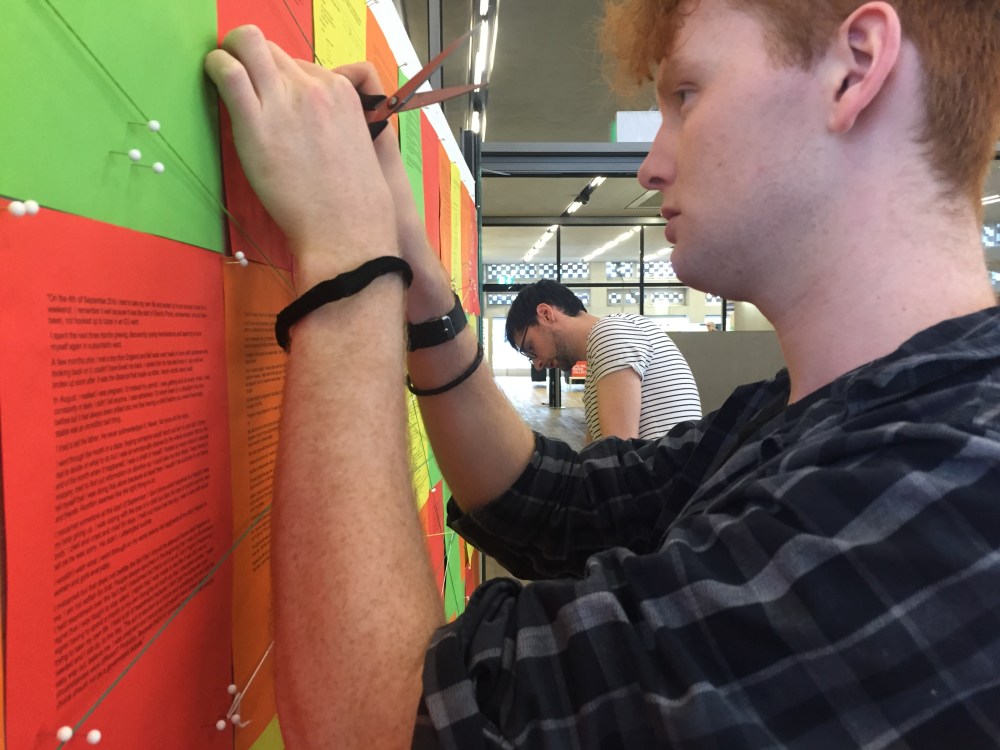Arts Work of the Future
Tate Exchange Tate Modern
06/03/18-08/03/18
On 6th March 2018 student members of Future Makers Collective (FMC) travelled to the Tate Exchange at Tate Modern London to present, research, collaborate and make new work with the Digital Maker Collective – a group of students from University of the Arts London – and interact with over 4,000 visiting members of the public at a major UAL/Tate Modern event Arts Work of the Future.

The students had been exploring information systems and digital practice, working with Andrei Molodkin at Rua Red Gallery to research hidden documents, producing digital work around themes such as data mining and pseudo-voluntary metadata collection, church/state entanglement and women’s health issues. The work they undertook in Tate Modern was an expansion of this to an international collaboration and audience.
TF, Future Makers Report June 2018
“I was approached by a Russian group who were attempting to digitise human beings by making our human forms into holograms and turning our mind into A.I. Their A.I. learned based on libraries of text that could be imported as YML files. We had the idea to give the A.I. a large text file that contained all our lonely tweets to see if the bot would essentially get depressed. This fit nicely with their goal for the day of feeding the bot Wittgenstein to see if it would start professing about the limits of language. I thought this was a great idea… the thought of making a sadbot, powered by the stray thoughts of thousands of lonely people on twitter.”
Students also worked with the TF twitter-bot text library and UAL students to create a loneliness-themed VR room in Unity – a virtual reality design engine. Similarly, FMC members E K and M K were introduced to concepts in augmented reality by working with UAL MFA students showcasing work in Microsoft Hololens examining the refugee crisis. This was a medium they had never experienced before, and opened up new possibilities of modes of practice:
“I had the opportunity to experience using a mixed reality headset which I had never done before and I was able to use the software to scan T’s head and shoulders and create a 3D obj. file of him. When I was speaking to the man who owned this mixed reality headset he spoke of using it as an artist to create virtual sculptures which he placed in a gallery setting alongside a physical piece of work. I discussed with him the possibilities of 3D printing sculptural pieces rather than physically sculpting with clay and how this can help an artist who might have ideas and concepts involving sculpture but without the necessary skills to create a piece by hand. For instance, there was something in my personal projects that I wanted to do involving making body casts, being able to 3D print a body, this could then be used to create a positive mould. And while this can be done by hand with plaster and so on there is perhaps more room for error and requires some skill and space to complete, that I may not have. Talking about using mixed or virtual reality to create a gallery environment also made me think about how it can be used to combat issues surrounding physical space. These were all things I had never thought about before, so I enjoyed the process of being opened-up to new ways of thinking.”
E K, Future Makers Report June 2018
FMC members also engaged with other new technologies such as conductive paint and single board computers, and their possible roles in future creative practice:
“The UAL event offered some exciting ideas that could be introduced to our work such as conductive paint that allowed for interaction with objects. One group was using apples to play audio and in discussion with them we discovered that this is possible by conductive paint, which we ourselves hope to implement into our piece allowing for the strings to tell a story or become interactive adding another layer to our piece. We were also discussing about audio in our piece and I found a group who were visualising the audio plastic made when the microphone was pressed against it, but we could use a similar technique to them and visualise the audio of such a journey allowing for a further representation and spanning that of both senses in our piece; sight and sound. It was a great experience to have been given the opportunity to take part in allowing for further development of our work and inspiring us in other ways and mediums to work in that we can now implement into our pieces.”
M C, Future Makers Report June 2018



As well as collaborating with UAL students and tech/art collectives from around Europe, FMC members worked on several projects of their own, including a receipt-printer sculpture that printed live tweets on women’s rights all through International Women’s Day, data visualisations in Processing using flock movements of migrating birds, and a sound art piece based on the geolocation of major churches in every county in Ireland. All 6 FMC members collaborated on a preliminary iteration of a site specific piece entitled Journeys of the 8th. Arts Work of the Future coincided with International Women’s Day and the announcement of a referendum in Ireland on repeal of the 8th amendment of the Irish constitution, something FMC members had been actively canvassing for at home.


